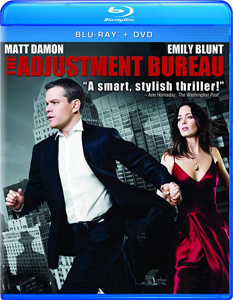Philip K. Dick fans have become accustomed to his short stories being used as foundations for action movies. So “The Adjustment Bureau” (2011) is a refreshing change of pace: Writer-director George Nolfi uses “The Adjustment Team” (1954) as the foundation for a romantic drama. PKD’s version is little more than an idea – albeit a fascinating one – sketched out in the form of a story: Adjusters nudge people down certain paths in life in order to serve a grand plan.
Nolfi builds on PKD’s ideas
Nolfi, in his fifth screenplay and directorial debut, smartly sees how PKD’s yarn can be extrapolated into an exploration of fate versus choice. The movie is not at all like the story in terms of narrative, but it’s thematically faithful, and the way it stitches multiple genres together is weird enough that it would’ve made PKD proud.
That said, the presence of Matt Damon and Emily Blunt is what first stands out about “The Adjustment Bureau,” and they are certainly the glue of this movie. Damon plays David Norris, the type of likable politician who only exists in movies. Continuing with the fictional tropes, Blunt plays Elise, initially a Manic Pixie Dream Girl. Their chemistry, as much as Nolfi’s writing, drives the romance as we get into the question of whether they are “meant to” be together.

“The Adjustment Bureau” (2011)
Director: George Nolfi
Writers: George Nolfi, Philip K. Dick
Stars: Matt Damon, Emily Blunt, Lisa Thoreson
Anthony Mackie’s Harry, the one Adjustment Bureau member who sympathizes with David’s yearning to break free of his political career path and follow his heart, fits the Magical Negro trope — at first. Both Elise and Harry become fuller characters. They don’t exist only to serve David’s needs; they make decisions based on their own moral compasses and emotions.
Elise’s first two meetings with David are meet-cutes – first in a men’s room when he’s planning his concession speech out loud, second on a bus when she drops his phone into a cup of coffee. It doesn’t get much more MPDG than that.
But Elise sobers up as a character as the film goes forward. She has a ballet career and a life outside of David. I suspect the movie could’ve been told from Elise’s perspective and covered the same thematic beats.
Romance gives way to philosophy
The romance genre makes room for philosophy in the second act when David learns about the Adjustment Bureau. As with the short story, I love the fact that the lead adjuster, Richardson (John Slattery, who is exactly who you’d picture in this role), simply tells our hero what’s up.
There is a threat hanging over David – the adjusters will wipe his brain if he tries to break free from the divine plan – but at least they aren’t killers. And Richardson’s boss, Thompson (Terence Stamp at his most Terence Stampish), stops by to espouse some more philosophy about free will. The stakes of any romantic plunge are writ large, something that’s hilariously absurd yet emotionally real.

The final act probably would be more talked about if it didn’t come after “The Matrix” and “Inception,” but it’s still pretty neat the way David and Emily teleport throughout New York City via doors that magically lead to different places (as long as David wears his hat and turns the knob to the left).
A good chunk of the final act is the romance cliché of the guy chasing down the girl before she marries the “wrong” man (“that guy,” as David calls the barely defined fiancé) – again with those even bigger stakes.
Just because PKD’s name is attached, I kind of hoped for some weirder twists, but I can’t complain too much about this consistently likable movie. “The Adjustment Bureau” stitches together the romance genre with a crazy PKD notion, so we’re left with an unusually creative version of the former and a faithful-in-spirit adaptation of the latter. It’s weird for a mainstream movie, and mainstream for a weird movie, but that teetering balance is appealing.

